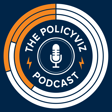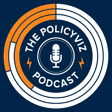
Flowers and Numbers: Natalia Kisileva’s Journey of Creativity and Community
In this week’s episode, I interview Natalia Kisileva about her transition from engineering to data visualization and her work in data art and physicalization. We discuss her great Substack newsletter “Flowers and Numbers” and how she shifted her focus to data art, fostering community-building efforts, after the pandemic. Natalia emphasizes making data accessible through tangible experiences and highlights the importance of community, particularly in initiatives like a Telegram group for women learning interactive visualizations. Our conversation explores the relationship between physical and digital data art, and Natalia advocates for creative visualizations to engage audiences emotionally and enhance communication. Learn more about Natalia’s work and how you can bring data art and data physicalization into your own work!
Keywords: PolicyVizPodcast, JonSchwabish, NataliaKisileva, EngineeringToDataVisualization, DataArt, Physicalization, FlowersAndNumbers, PandemicShift, CommunityBuilding, TangibleData, DataAccessibility, TelegramGroup, WomenInVisualization, InteractiveVisualizations, PhysicalVsDigital, CreativeVisualizations, EmotionalEngagement, CorporateCommunication, ArtisticDataPresentations, InPersonInteractions, 3DPrinting, TravelInspiredArt, MothersExperiences, StrengthAndBravery, SupportiveCommunity, NewsletterEngagement
Subscribe to the PolicyViz Podcast wherever you get your podcasts.
Become a patron of the PolicyViz Podcast for as little as a buck a month
Sign up for Natalia’s Flowers and Numbers newsletter and check out her website.
Follow me on Instagram, LinkedIn, Substack, Twitter, Website, YouTube
Email: jon@policyviz.com

